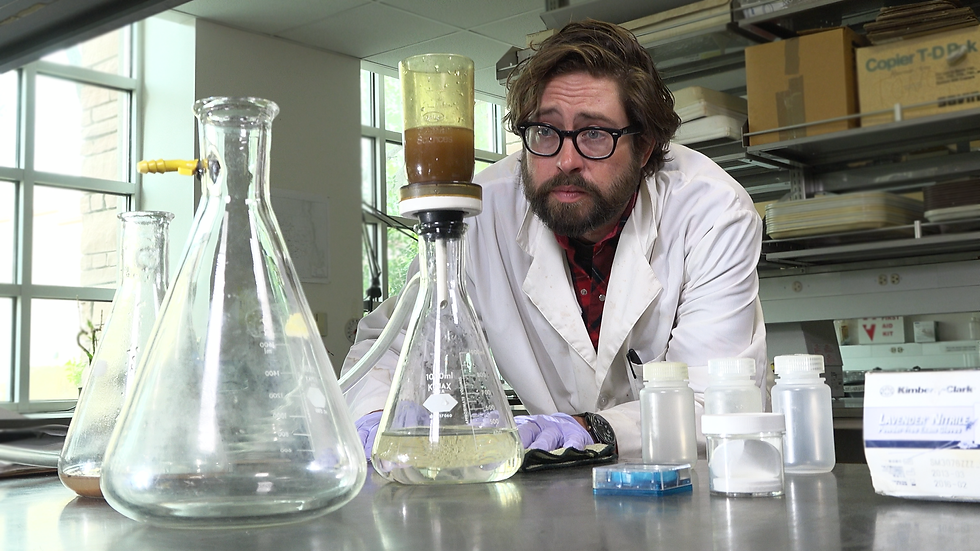A Day on the Range: Jornada Basin Long Term Ecological Research
- Tomilee Turner

- Aug 10, 2022
- 3 min read
Updated: Feb 2, 2023
"Does your departmental vehicle have 4-wheel drive?" I knew when Madeleine Soss, program manager of the Jornada Basin Long Term Ecological Research (LTER) program, asked me that question, I was going to be visiting some exclusive locations that non-researchers rarely get to experience.

We were producing a video about the Jornada Basin LTER program in preparation for an upcoming visit by representatives of the National Science Foundation. Because these reps would not have time to visit the remote research sites of the Jornada Experimental Range, our video needed to bring the beauty of the Chihuahuan Desert to them.
Early one morning, in the shadow of Wooton Hall, I loaded my video gear in a Chevy 4-wheel drive truck. Madeleine and I joined a few of the other Jornada Basin LTER staff, including Principal Investigator and NMSU Plant and Environmental Sciences professor Niall Hanan, field technicians Seth Hall, Conrad Nelson, and Herman Campos, and USDA physical science technician Ruben Baca. As our convoy approached the gate at the Jornada Experimental Range, I was reminded that the Range is made up of more than one research site. The Jornada Experimental Range is managed by the USDA Agricultural Research Service, while the Chihuahuan Desert Rangeland Research Center is operated by NMSU.

These two sites were established
in the early 1900s in response to the desertification of this land that began well over 100 years ago. What was once a lush, sprawling grassland was reduced in places to sand dunes and subject to shrub encroachment due to many years of extreme drought and livestock overgrazing. Enter NMSU professor and botanist Elmer Wooton, who in 1912 began to study this ecological “state” transition. Today, the continued and varied research conducted by the Jornada LTER program plays a significant role in the management of arid and semi-arid lands around the world by contributing to important long-term data. Long-term data has the power to inform our important decisions, such as the best ways to manage our natural resources and mitigate the effects of climate change. How long will it take for healthy grasslands to return?

Will they return? Researchers here study changes in soil carbon, weather, water flux, and plant community. They also monitor livestock grazing and the relationship between the land and its wildlife, ranging from kangaroo rats and jackrabbits to mule deer and coyotes.

In fact, on the way to our first site, we were lucky enough to find and film a herd of over
30 African oryx that roam freely on these lands. (Oryx were introduced to Southern New Mexico in the mid 20th century as a game animal.) Ruben captured some amazing drone footage. Ruben also uses his drone, outfitted with GPS, to document plant growth and other changes throughout the year.

Our first site was Mt. Summerford, an archeological site located in the heart of the range, which is rich in the history of the indigenous groups that migrated through the Jornada Basin. With this majestic peak behind us, we filmed our intro and discussed the importance of the research program. As we moved on to other locations on the range, everyone’s respect and love for the land became contagious. Seth and Conrad collected line transect and weather station data, and Herman examined some rare native grasses. However, I filmed only a small sampling of the Jornada LTER’s body of work in the field that day. Jornada researchers monitor this ecosystem at all scales – from the massive fluxes of carbon and water in the atmosphere to the microscopic biocrust formations in the soil.

We wrapped up production by filming in one of Wooten Hall’s science labs, where Seth and Conrad process their field samples, and also by making one final trip to the range with Plant and Environmental Sciences undergraduate student Shelley Valdovinos. The Jornada Basin LTER program includes graduate students and professors from NMSU and other universities, NMSU undergraduate students, USDA soil scientists and ecologists, statisticians, hydrologists, information technology specialists, and a variety of researchers from around the world. The site is part of a larger National Science Foundation network of long-term ecological research sites, and experts here share their knowledge of dryland ecosystems on a national and international level.

Locally, the LTER program helps create outdoor recreation spaces and inclusive science education programs in schools via their non-profit partner, the Asombro Institute for Science Education. Because ~40% of the Earth’s land surface is covered by drylands, the research that began here well over a century ago, and continues today, offers crucial insights into the degradation and restoration of arid environments worldwide.

To watch the 6-minute video about the Jornada Basin LTER and find out more about the program and its research opportunities, visit
Written by Tomilee Turner, Video Unit Manager, Innovative Media Research and Extension, in collaboration with Madeleine Soss, Program Manager, Long Term Ecological Research Project, Jornada Experimental Range.


